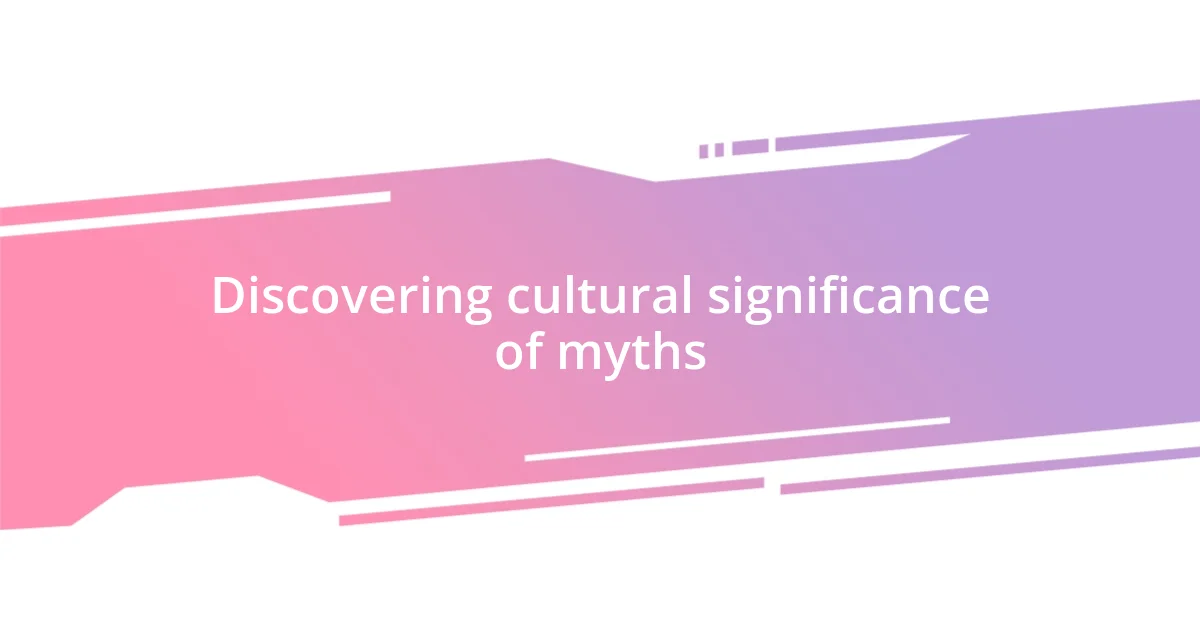Key takeaways:
- Ancient tales serve as moral guides and reflections of timeless human experiences, fostering connections to modern struggles.
- Myths encapsulate cultural significance and values, revealing societal norms and historical contexts that resonate with contemporary life.
- Creating inspired tales involves personal reflection, blending real-life experiences, and experimenting with narrative styles to deepen storytelling.

Understanding ancient tales
Ancient tales are fascinating windows into the values and beliefs of the cultures that created them. I remember the first time I read the “Epic of Gilgamesh.” It was astonishing to see how themes of friendship, mortality, and the quest for wisdom resonate even today. Have you ever thought about how these stories reflect our own struggles?
These narratives often serve as moral compasses, guiding us through the complexities of life. When I delve into tales like those of the Greek myths, I find myself reflecting on my own choices and ethics. How often do we overlook the lessons embedded in these stories, dismissing them as mere fiction rather than guidance for our own journeys?
Moreover, ancient tales are also rich in emotion, capturing the human experience in ways that remain profoundly relatable. I recall a particularly moving tale about the tragic love of Orpheus and Eurydice; it stirred a deep empathy within me. Isn’t it intriguing how these narratives traverse time, evoking feelings that resonate with our contemporary lives?

Discovering cultural significance of myths
Engaging with ancient myths opens up a treasure trove of cultural significance; each story encapsulates the essence of the civilization it stems from. For instance, when I explored the myths of the Aztecs, I was struck by the deep connection they had with nature and the cosmos. This reflection sparked in me a newfound appreciation for the natural world’s role in shaping culture and identity. It’s fascinating to think about how these stories served not only to entertain but also to educate individuals about their environment and place within it.
- Myths often reflect societal norms, such as gender roles or moral standards.
- They can reveal historical events and cultural shifts, giving insight into what mattered most to those societies.
- Many tales illustrate universal themes like heroism or betrayal, which continue to resonate in modern storytelling.
- Additionally, myths provide a sense of belonging and continuity, linking generations through shared narratives.
Unpacking these layers reminds me of the time I learned about the significance of the Hindu festival of Diwali through its mythological roots. The celebration isn’t just about lights and sweets; it’s deeply embedded in the triumph of good over evil, which left a lasting impression on me about the values we choose to celebrate as communities. Isn’t it comforting to see how these ancient stories still spark a sense of unity and understanding in our diverse world?

Analyzing character development in fables
Analyzing character development in fables unveils how transformational journeys unfold within concise narratives. Consider the tale of “The Tortoise and the Hare.” The hare, brimming with overconfidence, ultimately learns that consistent effort outshines arrogance. I still remember the lesson it instilled in me about perseverance in my own challenges. Have you ever experienced a moment where slow and steady progress brought unexpected success?
Looking deeper into fables, the characters often embody moral lessons that extend beyond their immediate actions. For instance, the clever fox in “The Fox and the Grapes” teaches us about rationalization and contentment. I’ve found myself in situations where I’ve dismissed unattainable goals, reminded by this fable that sometimes, it’s okay to accept what we cannot have. It’s curious how these little stories can reshape our thinking patterns.
When analyzing the development of characters through these ancient tales, I feel a profound connection to their struggles. Each character’s growth resonates with our personal journeys, packing valuable insights into seemingly simple narratives. The lessons imbued in these fables are not just for reflection; they are invitations to transform our attitudes and behaviors in everyday life.
| Fable | Main Character Development |
|---|---|
| The Tortoise and the Hare | Overcoming arrogance, understanding perseverance |
| The Fox and the Grapes | Learning contentment and rationalization |

Techniques for drawing inspiration
Drawing inspiration from ancient tales often starts with immersing oneself in the emotions these stories evoke. For me, reading the tragic love story of Orpheus and Eurydice elicits a profound sense of longing and loss. Have you ever felt your heart ache for a character’s misfortune? Channeling that emotion into my own creative endeavors can lead to powerful expressions of love and yearning.
Another technique is to identify and adapt the archetypes found in these narratives. I vividly recall brainstorming about the “mentor” role in stories, which brings to mind figures like Merlin or Yoda. These characters offer wisdom and guidance, allowing me to frame my own experiences as lessons learned from mentors I’ve encountered. Isn’t it enlightening to see how the guidance we receive shapes our paths?
Lastly, creating modern parallels to ancient tales can be incredibly invigorating. When I ponder the themes of sacrifice and dedication in the story of Prometheus, I often reflect on the personal sacrifices I’ve made for my creative passions. It’s intriguing to think about how these themes persist across time—changing in form but remaining significant. How can we not feel inspired when these connections between past and present illuminate our own lives?

Creating your own inspired tales
Creating your own inspired tales is a journey of self-discovery and expression. I’ve often found that leaning into what resonates with me—whether it’s the enactment of heroism or the complexity of unresolved conflict—can spark vibrant narratives. For example, while reflecting on the tragic story of Medea, I felt a rush of emotions about betrayal and resilience. This intense connection often guides me to craft my original tales, allowing my own experiences to echo through the characters and plots.
When it comes to weaving my stories, I like to infuse elements of my past that shaped my worldview. One time, I drew inspiration from an ordinary moment in my life, a simple walk in the park, where I spotted a pair of trees intertwined at their roots, battling for sunlight. I started narrating a tale about two best friends gradually growing apart due to life’s circumstances. It’s fascinating to consider how snippets from real life can sculpt intricate worlds and relatable characters.
I find that experimenting with different narrative styles enriches my storytelling too. Have you tried writing from the perspective of an object or an animal? I once penned a short story narrated by a songbird, capturing the struggles of seeking freedom. This unconventional approach not only energized my creativity but also helped me explore themes of liberation and constraint. It’s in these unique angles that inspiration flourishes, reminding us how diverse and personal storytelling can truly be.














